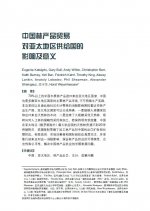The China Forest Products Trade (Chinese)
Overview of Asia-Pacific Supplying Countries, Impacts, and Implications
By Eugenia Katsigris, Gary Bull, Andy White, Christopher Barr, Keith Barney, Yati Bun, Fredrich Kahrl, Timothy King, Alexey Lankin, Anatoly Lebedev, Phil Shearman, Horst Weyerhaeuser, Su Yufang, Alexander Sheingauz - Forest Trends, University of British Columbia, Forest Trends, Center for International Forestry Research, York University, Foundation for People and Community Development, World Agroforestry Centre, Forest Information Systems, Far Eastern Ecoregional Project, Worldwide Fund for Nature , Bureau for Regional Oriental Campaigns, University of Papua New Guinea, World Agroforestry Centre, World Agroforestry Centre, Economic Research Institute, Russian Academy of Sciences View PublicationOver 70 percent of China’s timber product imports are supplied by countries in the Asia-Pacific region; and China is the dominant forest product market for many of these countries. Unsustainable harvesting practices, illegal logging, and negative impacts on community livelihoods plague many of these supplying countries. These countries may be divided into those still harvesting and exporting timber from natural forests on a large scale and those past their highest levels of natural forest timber harvesting and now more aggressively pursuing plantations and processing. Aside from Russia, China’s top Asia-Pacific timber suppliers could at best maintain current supply, with natural forest resources being depleted in less than 20 years. Resource limits also constrain expansion and/or longterm continuation of processed product export to China. Greater attention and action on
the part of governments, market leaders, and international organizations is needed to address negative impacts, shifting supply to a sustainable, legal, and equitable basis, and to determine from where China’s long-term supply will come.

